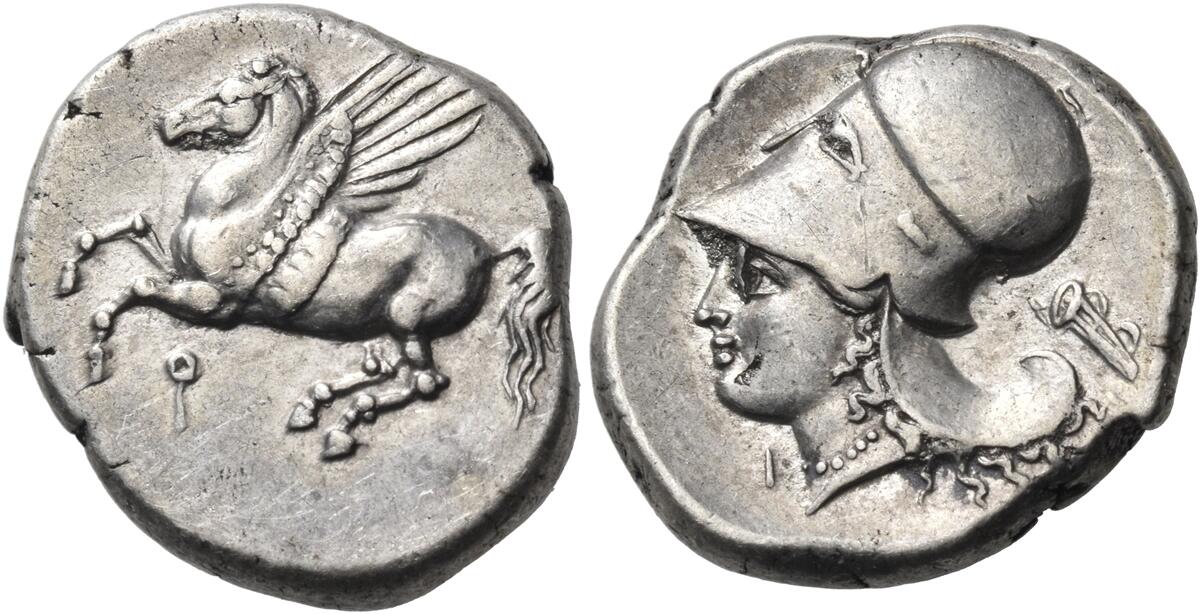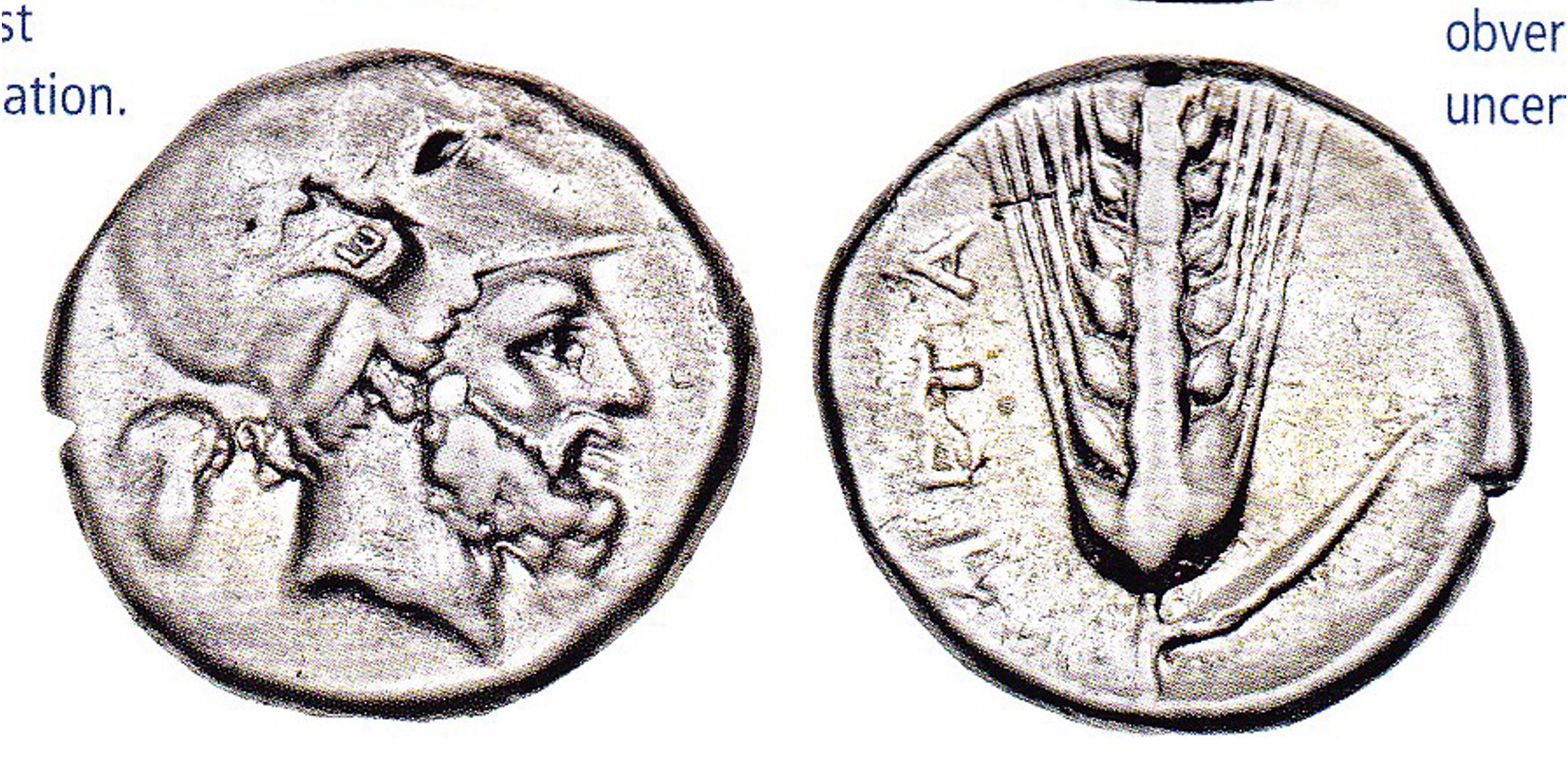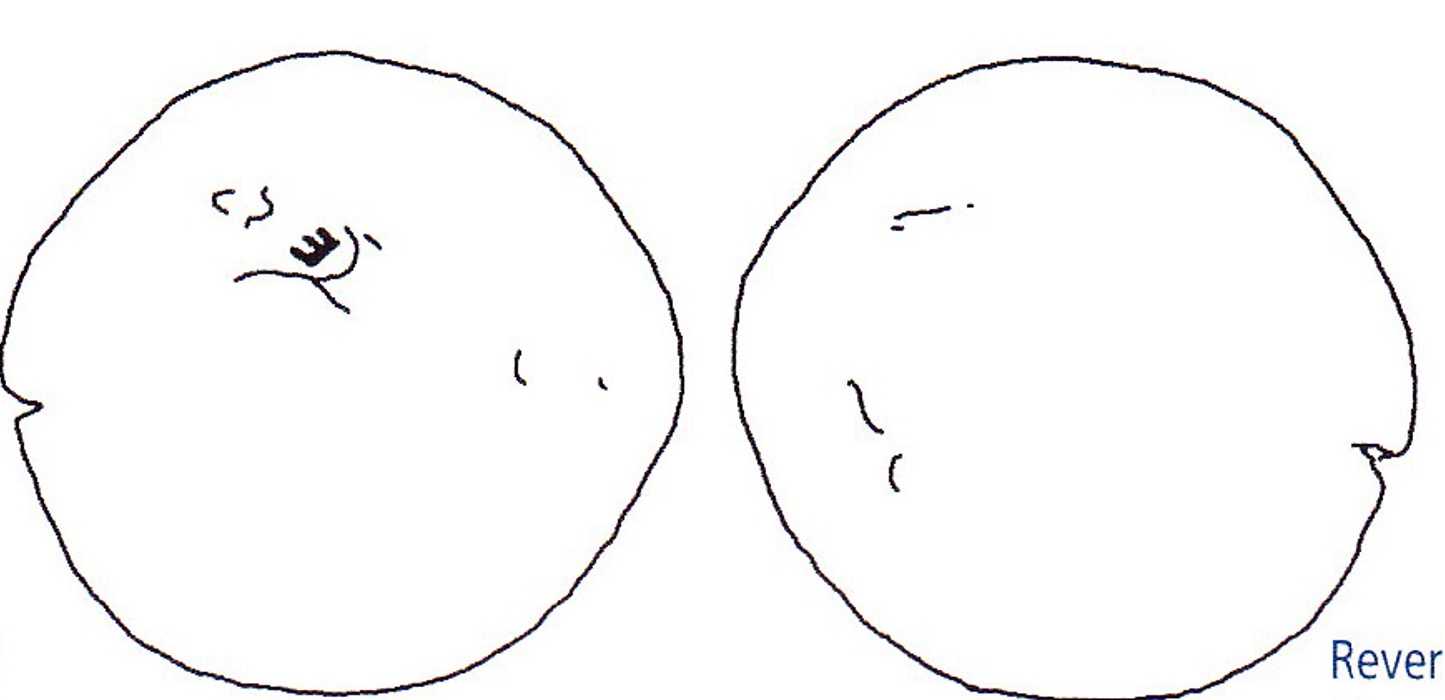1898 - Metapontum (nomos Leucippus/ear of barley) over Corinth (Pegasus/Athena) (MacDonald coll. 17): Difference between revisions
From SILVER
No edit summary |
|||
| Line 4: | Line 4: | ||
|Image overstruck variety=Pegasus Corinth Aphrodite helmet torch.jpeg | |Image overstruck variety=Pegasus Corinth Aphrodite helmet torch.jpeg | ||
|Image reference overstruck variety=https://pro.coinarchives.com/a/lotviewer.php?LotID=2007370&AucID=4767&Lot=119 | |Image reference overstruck variety=https://pro.coinarchives.com/a/lotviewer.php?LotID=2007370&AucID=4767&Lot=119 | ||
|Private collection=David MacDonald collection | |Private collection=David MacDonald collection, n° 17 | ||
|Obverse description=Head of Leucippus right, wearing Corinthian helmet. In field, grape bunch. | |Obverse description=Head of Leucippus right, wearing Corinthian helmet. In field, grape bunch. | ||
|Reverse legend=META | |Reverse legend=META | ||
| Line 10: | Line 10: | ||
|Reverse description=Ear of wheat with leaf. | |Reverse description=Ear of wheat with leaf. | ||
|Mint=Metapontum | |Mint=Metapontum | ||
|Ancient region= | |Ancient region=Lucania | ||
|Date from= | |Date from=339 BCE | ||
|Date to= | |Date to=330 BCE | ||
|Period=Classical | |Period=Classical | ||
|Metal=Silver | |Metal=Silver | ||
|Weight=7.64 | |Weight=7.64 | ||
|Axis=11 | |Axis=11 | ||
|Denomination= | |Denomination=nomos | ||
|Standard=Achaian | |Standard=Achaian | ||
|Coin reference=MacDonald 2009, p. 25-26, n° 17 | |Coin reference=MacDonald 2009, p. 25-26, n° 17 | ||
|Coin series reference=HN Italy, n° 1552-1553.; HGC 1, n° 1053 | |Coin series reference=MacDonald 2009, p. 25-26, n° 17; HN Italy, n° 1552-1553.; HGC 1, n° 1053 | ||
|Coin series web reference=https://greekcoinage.org/iris/id/metapontum.hn_italy.1552-1553 | |Coin series web reference=https://greekcoinage.org/iris/id/metapontum.hn_italy.1552-1553 | ||
|Overstruck obverse legend=Koppa | |Overstruck obverse legend=Koppa | ||
| Line 28: | Line 28: | ||
|Overstruck mint=Corinth | |Overstruck mint=Corinth | ||
|Overstruck ancient region=Peloponnesus | |Overstruck ancient region=Peloponnesus | ||
|Overstruck date from=400 BCE | |||
|Overstruck date to=330 BCE | |||
|Overstruck period=Classical | |||
|Overstruck denomination=stater | |Overstruck denomination=stater | ||
|Overstruck standard=Aeginetic | |||
|Coin series reference overstruck=Calciati 1990, Corinth Period V, Series 1, n° 372. | |Coin series reference overstruck=Calciati 1990, Corinth Period V, Series 1, n° 372. | ||
|Frequency of overstrikes=frequent | |||
}} | }} | ||
Revision as of 07:48, 24 August 2023
339 BCE - 330 BCE | META
Images
Overstruck variety Traces of the overstruck variety
Traces of the overstruck variety

Pegasus Corinth Aphrodite helmet torch.jpeg [1]
Location/history
| Private collection(s)Private collection(s) ᵖ: | David MacDonald collection, n° 17 |
Overstriking coin
Description
| ObverseInscription or printing placed on the obverse.: | Head of Leucippus right, wearing Corinthian helmet. In field, grape bunch. | ReverseInscription or printing placed on the reverse.: | META (Greek) Ear of wheat with leaf. |
Mint and issuing power
| MintIdentifies the place of manufacture or issue of a numismatic object.: | Metapontum | Ancient regionAncient region. | Lucania | Modern countryModern country: Italy | AuthorityIdentifies the issuing power. The authority can be "pretended" when the name or the portrait of X is on the coin but he/she was not the issuing power. It can also be "uncertain" when there is no mention of X on the coin but he/she was the issuing power according to the historical sources: |
Chronology
| FromIdentifies the initial date in a range assigned in a numismatic context. 339 BCE toIdentifies the final date in a range assigned in a numismatic context.. 330 BCE | Classical 480-323 BC |
Physical description
| MetalThe physical material (usually metal) from which an object is made.: Silver |
WeightWeight of the numismatic object (in grams). in grams: 7.647.64 g <br />7,640 mg <br /> | DenominationTerm indicating the value of a numismatic object. Examples: tetradrachm, chalkous, denarius.: nomos | AxisDescribes the directional relationship between the obverse and reverse of a numismatic object.: 1111 mm <br />1.1 cm <br /> |
| StandardStandard.: Achaian | |||
References
| Coin referenceReference of the Coin: | MacDonald 2009, p. 25-26, n° 17 | Coin series referenceReference to coin series study: | MacDonald 20091MacDonald 2009, p. 25-26, n° 17, HN Italy2HN Italy, n° 1552-1553., HGC 13HGC 1, n° 1053 |
| Coin series web referenceCoin series web references: | |||
Overstruck type
Description
| ObverseInscription or printing placed on the obverse.: | Koppa (Greek) Pegasus flying left (visible: slight traces). | ReverseInscription or printing placed on the reverse.: | Head of Aphrodite left, wearing Corinthian helmet. Behind, E and race torch (visible: outline of small portion of back of helmet bowl, neck guard, traces of hair curls, E, and partial outline of left side of race torch). |
Mint and issuing power
| MintIdentifies the place of manufacture or issue of a numismatic object. ᵖ: | Corinth | Ancient regionAncient region. ᵖ | Peloponnesus | Modern countryModern country: Greece | AuthorityIdentifies the authority in whose name (explicitly or implicitly) a numismatic object was issued. ᵖ: |
Chronology
| FromIdentifies the initial date in a range assigned in a numismatic context. 400 BCE toIdentifies the final date in a range assigned in a numismatic context.. 330 BCE | Classical 480-323 BC |
Physical description
| DenominationTerm indicating the value of a numismatic object. Examples: tetradrachm, chalkous, denarius. ᵖ: | stater |
StandardStandard. ᵖ: | Aeginetic |
References
| Coin type referenceReference to coin series study ᵖ: | Calciati 19904Calciati 1990, Corinth Period V, Series 1, n° 372. |
Additional data
| Frequency of overstrikesFrequency of overstrikes: | frequent | Level of confidenceLevel of confidence of the identification: | |
| RemarksRemarks: | |||
References
- ^ Macdonald, David (2009), Overstruck Greek coins: studies in Greek chronology and monetary theory, Whitman Publishing, Atlanta.
- ^ Rutter N. Keith et alii (eds.) (2001), Historia Numorum Italy, London, xvi, 223 p., 43 pl.
- ^ Hoover, Oliver D. (2018), The Handbook of Greek Coinage Series, Volume 1. Handbook of Coins of Italy and Magna Graecia, Sixth to First Centuries BC., Lancaster-London, 2018, lxi, 527 pages, 23 cm
- ^ Calciati, Romolo (1990), Pegasi, Mortara, Edizioni I.P..

